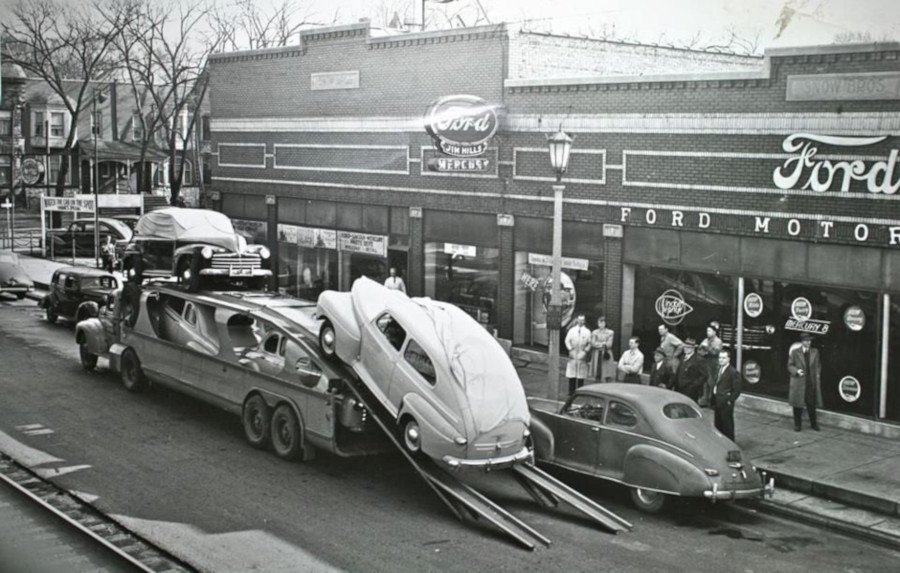By Robert Tate, Automotive Historian and Researcher
Images Courtesy of the Ford Motor Company Archives & Roy O’ Brien Ford
Published 1.25.2023

Henry Ford built his first automobile in 1896, known as the Quadricycle. This started his great journey and created a chapter in automotive history recognized by people worldwide.
In 1913, Ford started to manufacture Model Ts after perfecting a moving assembly line that created many jobs for American workers and put America on wheels. This is a brief look at how one of the largest automakers created and sold Ford vehicles through dealerships for more than a hundred years.  1903 Ford Model A with Edsel Ford II, William Clay Ford Jr and William Clay Ford Sr (Ford Motor Co Archives)
1903 Ford Model A with Edsel Ford II, William Clay Ford Jr and William Clay Ford Sr (Ford Motor Co Archives)
The first Ford dealership was opened on January 15, 1903 by William L. Hughson in San Francisco, California and was very successful. In 1903, Ford was selling the original Model A. Within their first three and one-half months of operations, Ford Motor Company made a profit of $36,957 thanks to the popularity of the Model A. In November 1903, Henry Ford was elected as vice president of the Ford Motor Company.
 A Ford Model T ad (Ford Motor Co Archives)
A Ford Model T ad (Ford Motor Co Archives)
As the great success of Ford Motor Company would continue, the number of dealerships also grew. Many automotive historians have said that the introduction of the Model T beginning in 1908 and its explosive sales helped Ford expand its dealership network across America. Over its product life, the “Tin Lizzie” sold more than 15 million units.
 A Ford dealership, 1930s (Ford Motor Co Archives)
A Ford dealership, 1930s (Ford Motor Co Archives)
By the 1930s, Ford dealerships would undergo more changes and offer more great product options for the driving public. During the Great Depression in 1932, Ford introduced its first automobile with a V8 engine. Selling a new car during that era was no easy task because of the “Great Depression” that took in place in our country with the loss of so many jobs. When Ford announced the price for the new V-8 models, the public was pleased to hear that they could afford the cost, which was only $10 more than their four-cylinder cars. This announcement inspired many to rush to Ford dealerships to purchase the 1932 V8s, the most popular of which was the Deluxe Tudor at a price of $550.
 A Ford dealership 1939-40 (Ford Motor Co Archives)
A Ford dealership 1939-40 (Ford Motor Co Archives)
When America entered World War II, Ford Motor Company shifted production to assemble military vehicles and aircraft. After the war ended, Ford and their dealerships, like every other American automaker, had a difficult time selling new vehicles because of a shortage of assembly components.
On February 5, 1947, Jack Davis, Ford’s vice-president in charge of sales and advertising, gave a talk to their dealers, saying: “The phenomenal growth of Ford Motor company is one of the most outstanding achievements of industrial developments in world history.”
 Roy O'Brien Ford, 1946 (Roy O'Brien Ford)
Roy O'Brien Ford, 1946 (Roy O'Brien Ford)
In 1949, Ford Motor Company celebrated the new styling on its line of new models. The sleek, slab-sided 1949 Fords became a huge success and generated huge profits. Dealerships could not keep up with demand.
The 1950s and 1960s saw more successes at Ford dealerships across the country because of great looking iconic models like the 1955 Ford Thunderbird and the Mustang, introduced in 1964.
 A Roy O'Brien Ford ad promoting the Mustang
A Roy O'Brien Ford ad promoting the Mustang
In Michigan, popular early Ford dealerships included Stark Hickey Ford, (located on Grand River) Al Long Ford, and Roy O’Brien Ford. Roy O’Brien opened for business on March 14, 1946, with an investment of $50,000 and ten employees. During the early 1960s, as a young kid, I would run to the television set to see and hear the Roy O’ Brien Ford commercial with its distinctive jingle: “Stay on the right track, to 9 Mile & Mack.” This dealership commercial was very popular and is still remembered today.
 A Roy O'Brien Ford 2013 ad
A Roy O'Brien Ford 2013 ad
In conclusion, Ford dealerships have long been a part of American automotive history and are still evolving to serve generations to come.
Bibliography
Krigsman, Amy. “History of the Ford Dealership in America.” Ford Car Life Nation, January 13, 2018.
Dammann, George H. “Illustrated History of Ford.” Crestline Publishing, 1970.
Sorensen, Lorin. “The American Ford.” Silverado Publishing, 1975.



